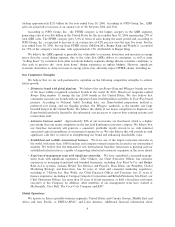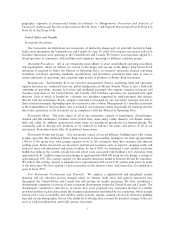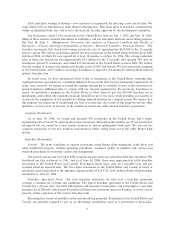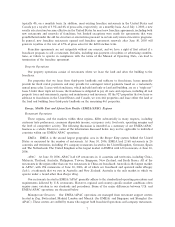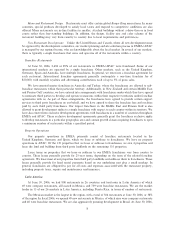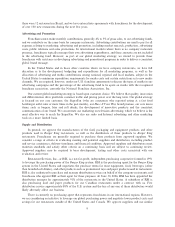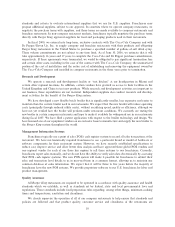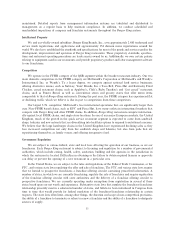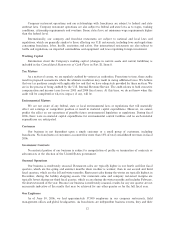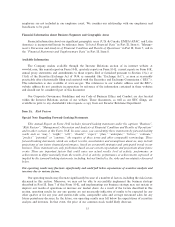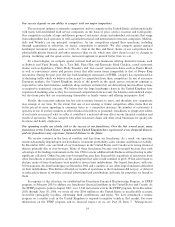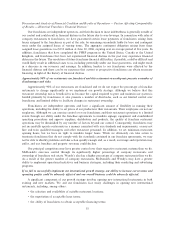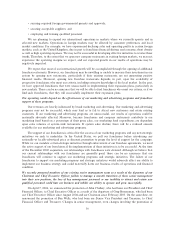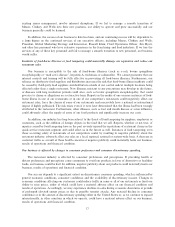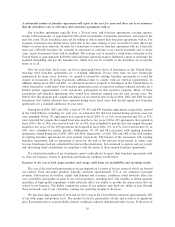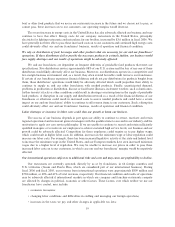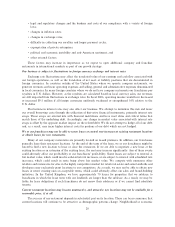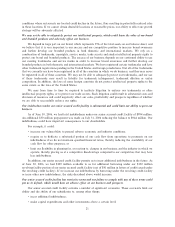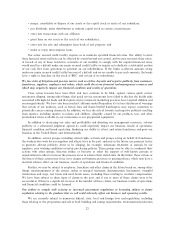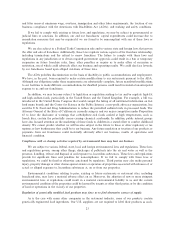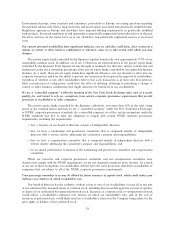Burger King 2006 Annual Report Download - page 26
Download and view the complete annual report
Please find page 26 of the 2006 Burger King annual report below. You can navigate through the pages in the report by either clicking on the pages listed below, or by using the keyword search tool below to find specific information within the annual report.Our success depends on our ability to compete with our major competitors.
The restaurant industry is intensely competitive and we compete in the United States and internationally
with many well-established food service companies on the basis of price, service, location and food quality.
Our competitors include a large and diverse group of restaurant chains and individual restaurants that range
from independent local operators to well-capitalized national and international restaurant companies. McDon-
ald's and Wendy's are our principal competitors. As our competitors expand their operations, including
through acquisitions or otherwise, we expect competition to intensify. We also compete against regional
hamburger restaurant chains, such as Carl's Jr., Jack in the Box and Sonic. Some of our competitors have
substantially greater financial and other resources than we do, which may allow them to react to changes in
pricing, marketing and the quick service restaurant segment in general better than we can.
To a lesser degree, we compete against national food service businesses offering alternative menus, such
as Subway and Yum! Brands, Inc.'s Taco Bell, Pizza Hut and Kentucky Fried Chicken, casual restaurant
chains, such as Applebee's, Chili's, Ruby Tuesday's and ""fast casual'' restaurant chains, such as Panera Bread,
as well as convenience stores and grocery stores that offer menu items comparable to that of Burger King
restaurants. During the past year, the fast food hamburger restaurant, or FFHR, category has experienced flat
or declining traffic which we believe is due in part to competition from these competitors. In one of our major
European markets, the United Kingdom, much of the growth in the quick service restaurant segment is
expected to come from bakeries, sandwich shops and new entrants that are diversifying into healthier options
to respond to nutritional concerns. We believe that the large hamburger chains in the United Kingdom have
experienced declining sales as they face increased competition from not only the bakeries and sandwich shops,
but also from pubs that are re-positioning themselves as family venues and offering inexpensive food.
Finally, the restaurant industry has few non-economic barriers to entry, and therefore new competitors
may emerge at any time. To the extent that one of our existing or future competitors offers items that are
better priced or more appealing to consumer tastes or a competitor increases the number of restaurants it
operates in one of our key markets or offers financial incentives to personnel, franchisees or prospective sellers
of real estate in excess of what we offer, it could have a material adverse effect on our financial condition and
results of operations. We also compete with other restaurant chains and other retail businesses for quality site
locations and hourly employees.
Our operating results are closely tied to the success of our franchisees. Over the last several years, many
franchisees in the United States, Canada and the United Kingdom have experienced severe financial distress,
and our franchisees may experience financial distress in the future.
We receive revenues in the form of royalties and fees from our franchisees. As a result, our operating
results substantially depend upon our franchisees' restaurant profitability, sales volumes and financial viability.
In December 2002, over one-third of our franchisees in the United States and Canada were facing financial
distress primarily due to over-leverage. Many of these franchisees became over-leveraged because they took
advantage of the lending environment in the late 1990s to incur additional indebtedness without having to offer
significant collateral. Others became over-leveraged because they financed the acquisition of restaurants from
other franchisees at premium prices on the assumption that sales would continue to grow. When sales began to
decline, many of these franchisees were unable to service their indebtedness. Our largest franchisee, with over
300 restaurants, declared bankruptcy in December 2002 and a number of our other large franchisees defaulted
on their indebtedness. This distress affected our results of operations as the franchisees did not pay, or delayed
or reduced payments of royalties, national advertising fund contributions and rents for properties we leased to
them.
In response to this situation, we established the Franchisee Financial Restructuring Program, or FFRP
program, in February 2003 to address our franchisees' financial problems in the United States and Canada. At
the FFRP program's peak in August 2003, over 2,540 restaurants were in the FFRP program. From December
2002 through June 30, 2006, we wrote off over $106 million in the United States in uncollectible accounts
receivable (principally royalties, advertising fund contributions and rents). We have introduced a similar
program on a smaller scale in the United Kingdom to respond to negative trends in that market. For more
information on the FFRP program and its financial impact on us, see Part II, Item 7, ""Management's
14


